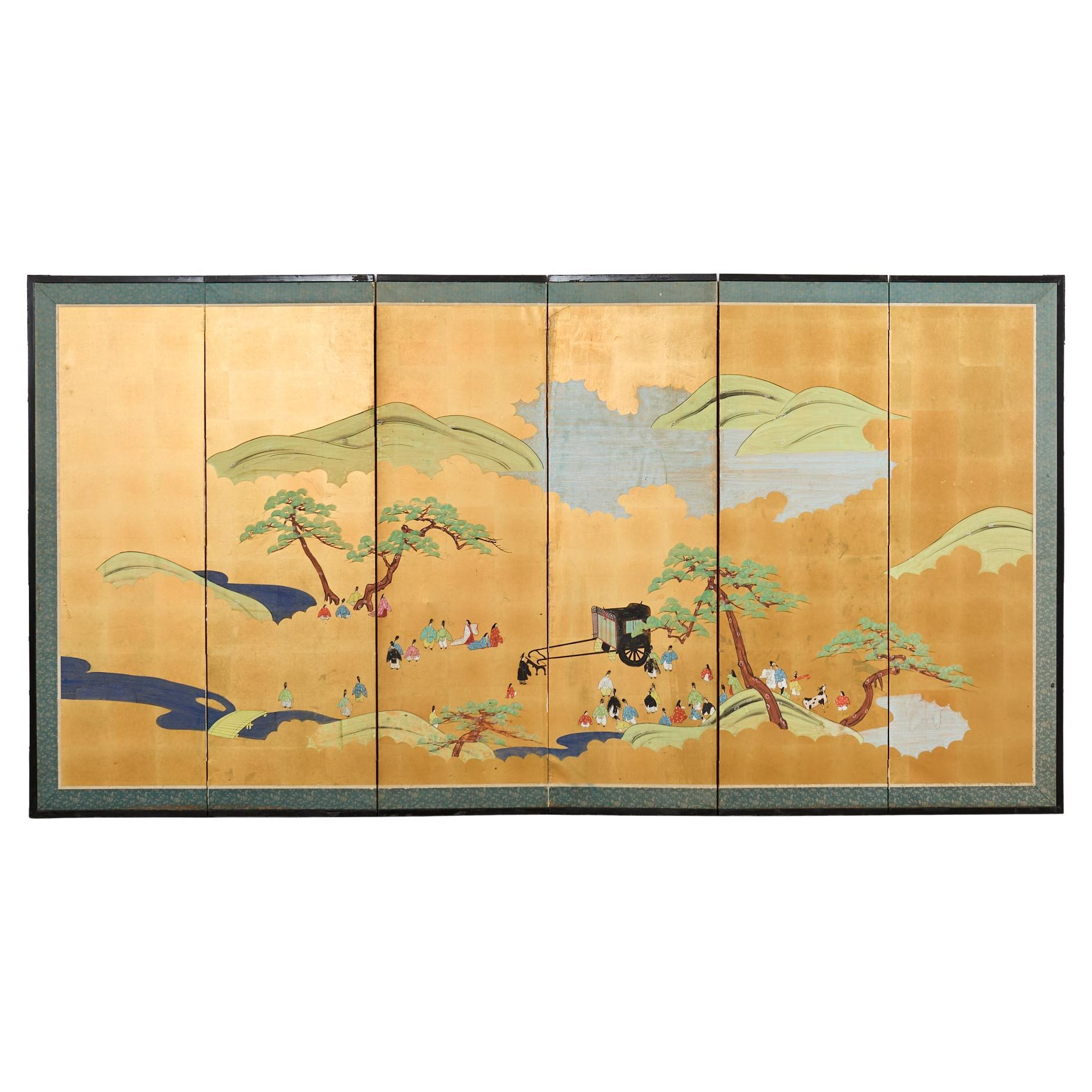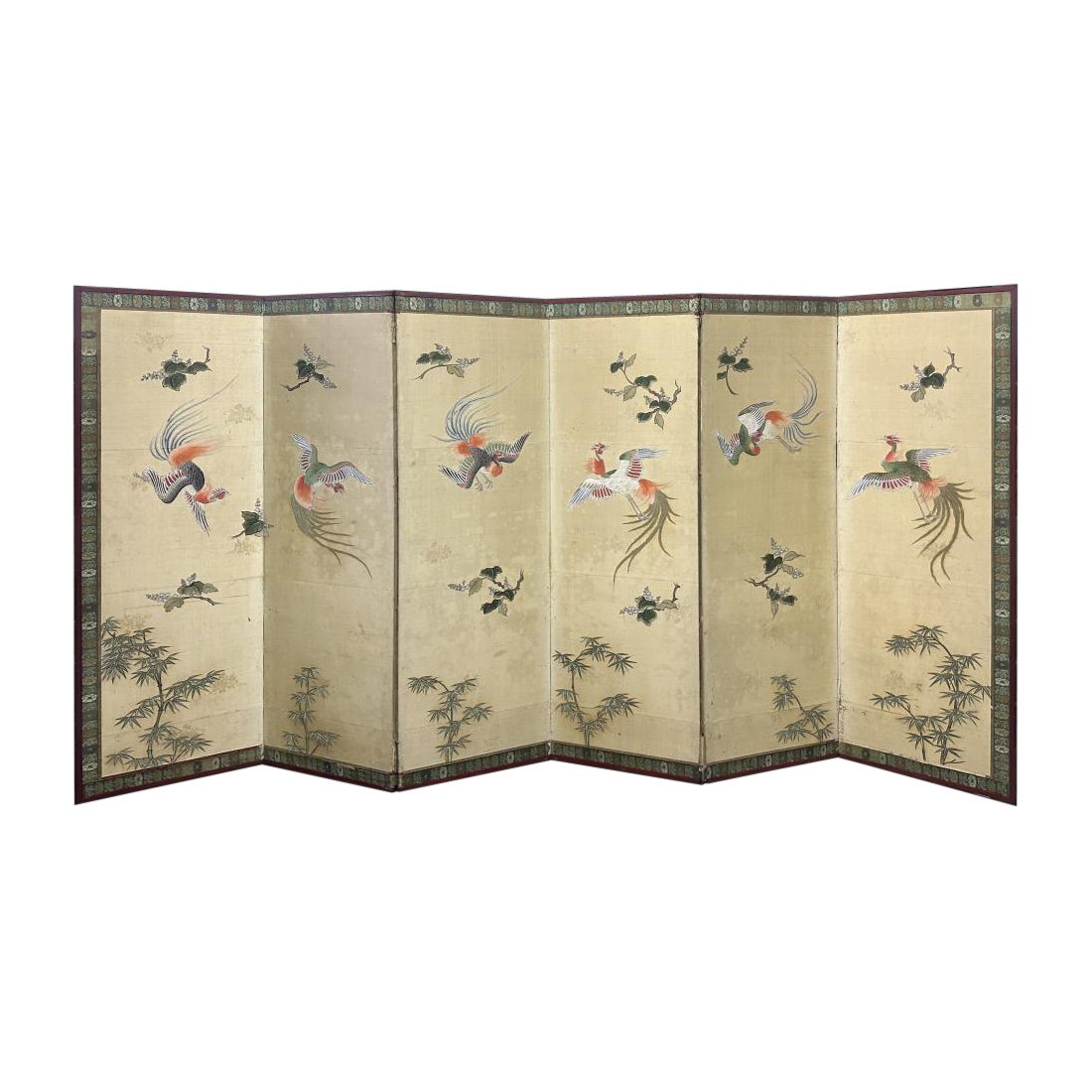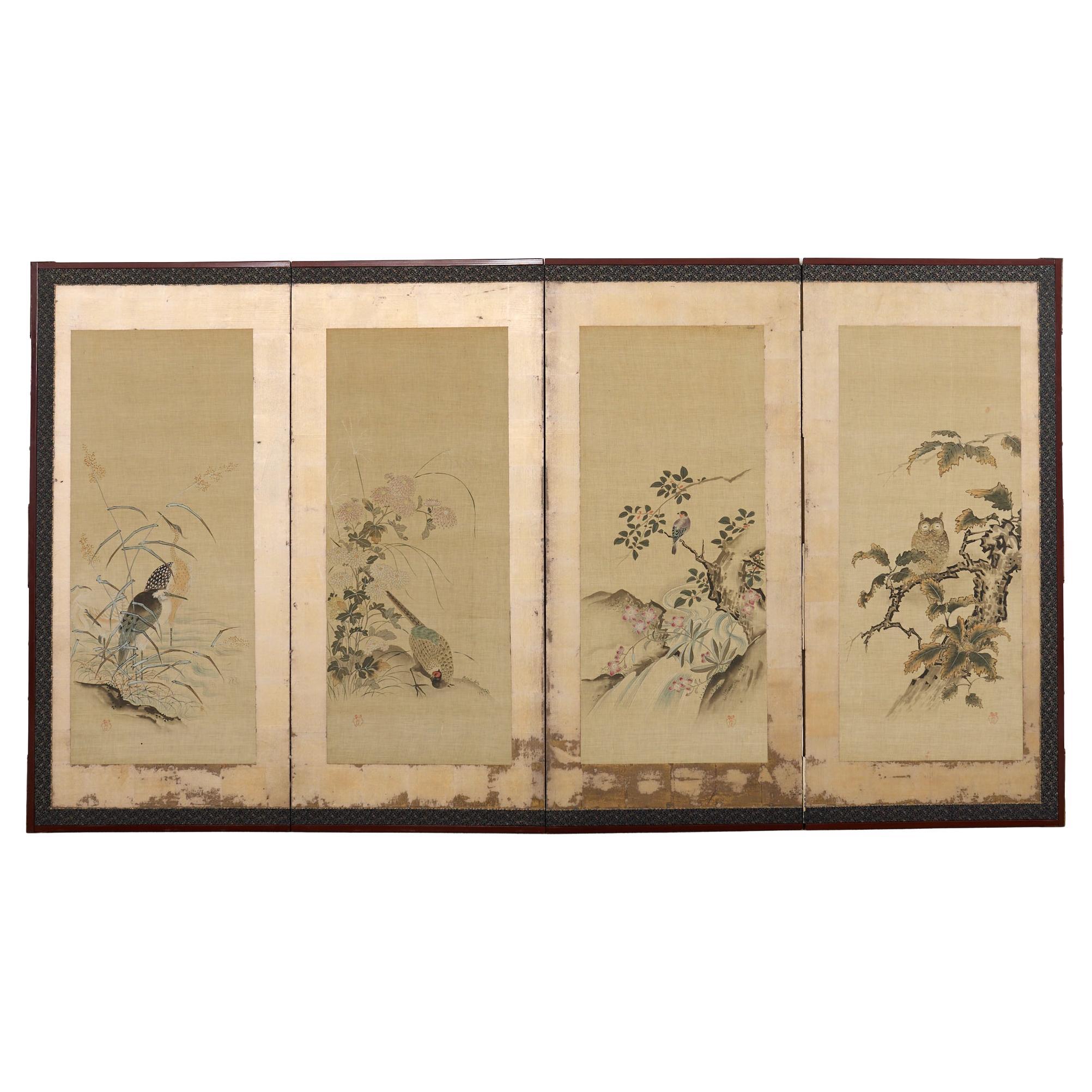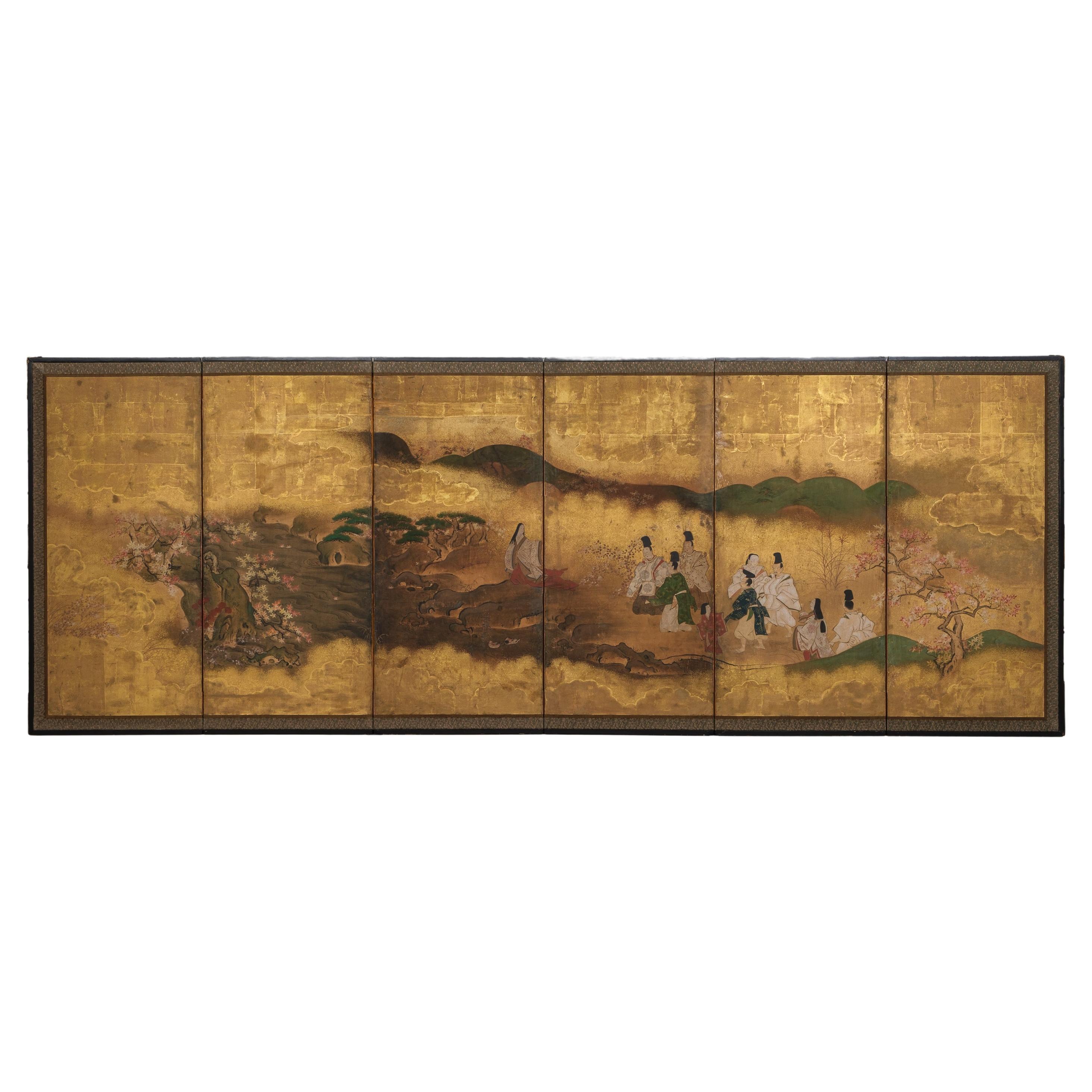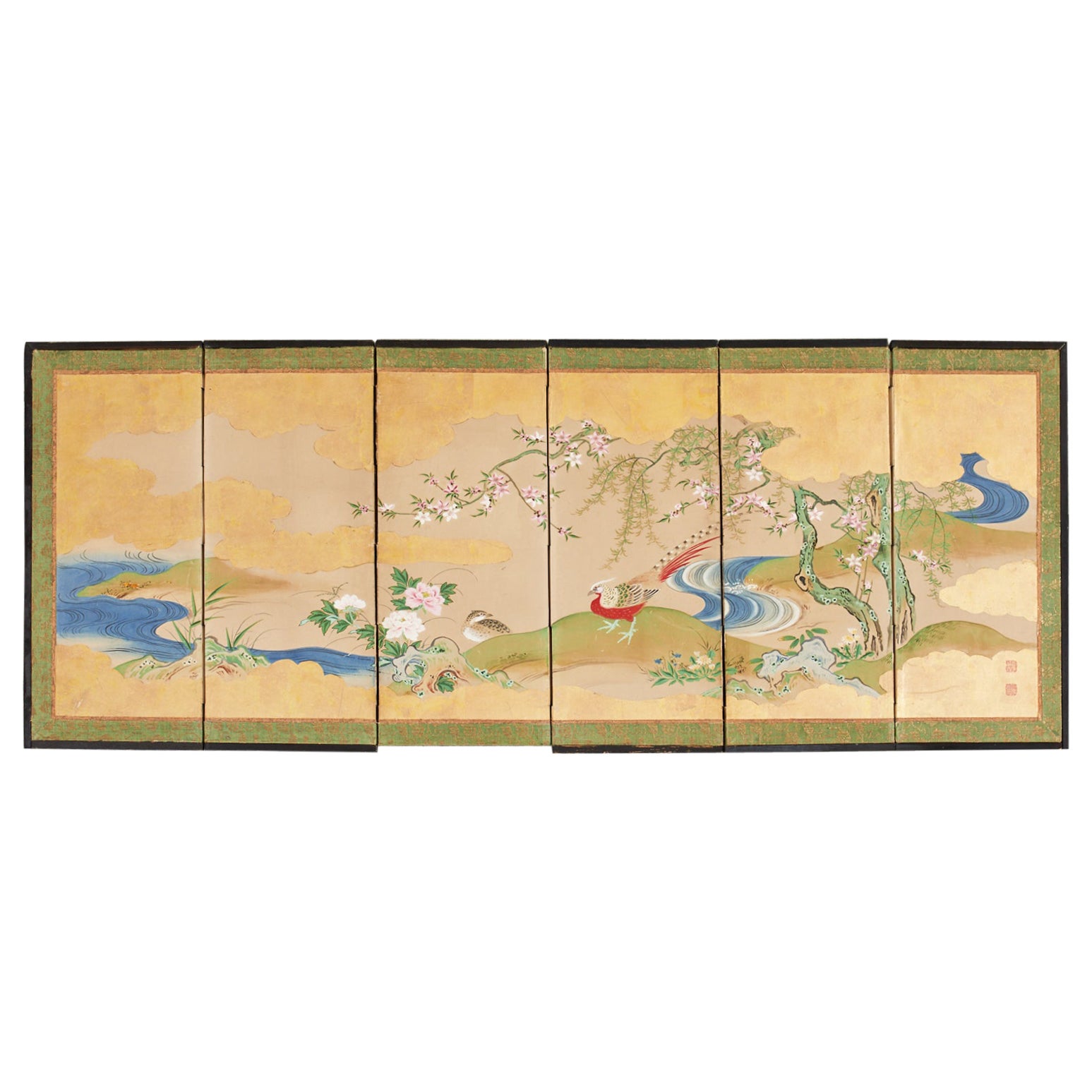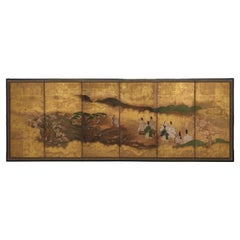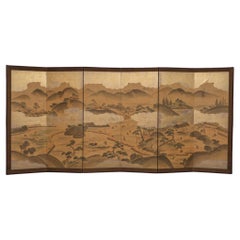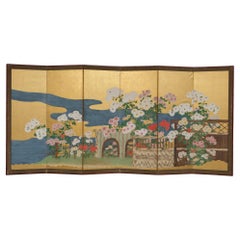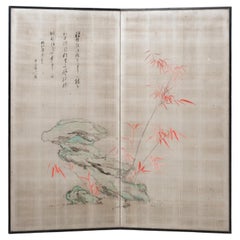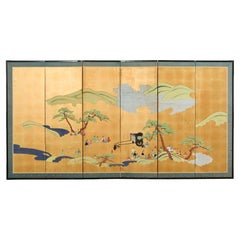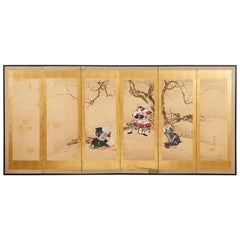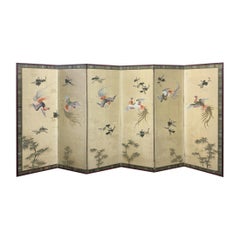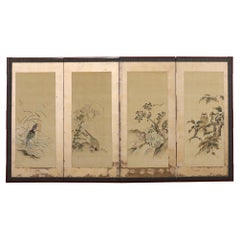Items Similar to Tall 6-panel byôbu with phoenixes attributed to Kanô Isen’in Naganobu
Want more images or videos?
Request additional images or videos from the seller
1 of 17
Tall 6-panel byôbu with phoenixes attributed to Kanô Isen’in Naganobu
$14,186.16
£10,680.74
€12,000
CA$19,579.02
A$21,932.83
CHF 11,407.80
MX$267,535.30
NOK 145,236.45
SEK 136,947.62
DKK 91,356.01
About the Item
An exquisite, tall six-panel byôbu (folding screen) featuring a painting attributed to Kanô Isen’in Naganobu (1775–1828) depicting a pair of phoenixes (hô’ô) and a section of a large ancient pine tree (matsu).
The male bird is perched gracefully on one leg atop the arching, moss-covered branch, his long bright white tail feathers trailing behind him, and his red neck turned toward the approaching hen. She is captured in mid-flight, her body coiled in a dynamic pose, flanked by two large trailing white feathers, and plumage filled with swirling strands of blue and green.
This elegant composition of phoenixes and pine brings together two powerful symbols of harmony and endurance. The phoenixes, embodying balance, represent marital harmony, peace, and prosperity, while the evergreen pine tree stands for longevity, steadfastness, and unchanging virtue. Together, they form a deeply auspicious motif — a wish for enduring love, resilience, and a life of peace and abundance.
With attributive signature and seal in the lower left corner. Signature: 'Painted by Isen Hôgen', Sealed: 'Sealed by Isen'.
Kanô Isen’in Naganobu (1775–1828) was a prominent painter of the late Edo period and the eighth-generation head of the Kobikichô branch of the Kanô school in Edo. Born as the son of Kanô Yôsen’in Korenobu, he inherited the leadership of the Edo Kanô lineage, which had been founded by Kanô Naonobu (1607–1650). Naganobu trained within the family atelier, where he had access to important collections of classical Chinese and Japanese paintings owned by the shogunate and daimyô families.
He was granted the prestigious Buddhist painter’s title Hôgen in 1802 and was later elevated to the highest rank of Hôin in 1816.
Rendered in polychrome natural pigments and ink on a shimmering gold leaf background. The screen is bordered by two silk trims: a slender brown brocade inner border and a broad golden-brown outer border with a chrysanthemum 菊 (kiku) motif. Framed within a black lacquered wooden frame fitted with protective metal hardware engraved with a scrolling foliage (karakusa) design.
Dimensions:
Total width: 148.42 in / 377 cm (2 x 25.39 in / 64.5 cm, 4 x 24.40 in / 62 cm); Height: 67.79 in / 172.2 cm
The folding screen is ideal for mounting flat on a wall and presenting as a single work of art.
When shipped we will add a certificate of authenticity.
Price including insured shipping.
- Attributed to:Kano Isen'in Naganobu (Painter)
- Dimensions:Height: 67.8 in (172.2 cm)Width: 148.43 in (377 cm)Depth: 0.67 in (1.7 cm)
- Materials and Techniques:
- Place of Origin:
- Period:
- Date of Manufacture:between 1802-1816 (Edo period)
- Condition:Wear consistent with age and use. Considering its age, the screen is in very good condition with minimal traces of wear consistent with age. Please refer to the photos for a clear condition reference.
- Seller Location:Amsterdam, NL
- Reference Number:Seller: D52211stDibs: LU7165245473972
About the Seller
4.8
Vetted Professional Seller
Every seller passes strict standards for authenticity and reliability
Established in 1996
1stDibs seller since 2022
22 sales on 1stDibs
Typical response time: 22 hours
- ShippingRetrieving quote...Shipping from: Zwanenburg, Netherlands
- Return Policy
Authenticity Guarantee
In the unlikely event there’s an issue with an item’s authenticity, contact us within 1 year for a full refund. DetailsMoney-Back Guarantee
If your item is not as described, is damaged in transit, or does not arrive, contact us within 7 days for a full refund. Details24-Hour Cancellation
You have a 24-hour grace period in which to reconsider your purchase, with no questions asked.Vetted Professional Sellers
Our world-class sellers must adhere to strict standards for service and quality, maintaining the integrity of our listings.Price-Match Guarantee
If you find that a seller listed the same item for a lower price elsewhere, we’ll match it.Trusted Global Delivery
Our best-in-class carrier network provides specialized shipping options worldwide, including custom delivery.More From This Seller
View AllMid-size 6-panel byôbu 屏風 with a scene from The Tale of Genji
Located in Amsterdam, NL
A refined medium-sized six-panel byôbu (folding screen) showcasing a classical autumn court scene from chapter 7 of The Tale of Genji (Genji Monogatari), titled Momiji no Ga (The Aut...
Category
Antique 17th Century Japanese Paintings and Screens
Materials
Metal, Gold Leaf
Large Japanese 6-panel byôbu 屏風 (folding screen) with genre painting
Located in Amsterdam, NL
Fascinating large six-panel byôbu (folding screen) with a detailed genre painting on goldish silver leaf with different scenes of people at work in a rural mountain village during th...
Category
Early 20th Century Japanese Paintings and Screens
Materials
Silver Leaf
Large Japanese 6-panel byôbu 屏風 (folding screen) with chrysanthemum garden
Located in Amsterdam, NL
A very colourful and captivating large six-panel byôbu (folding screen) with a refined continuous painting of a luscious flower garden filled with many different types of chrysanthemums (kiku), next to a winding river.
This multi-coloured painting is set on a shiny gold-leaf background, and the chrysanthemum flowers are painted by using shell paste (gofun) in low relief.
Several clutches with a great variety of chrysanthemum flowers are in full bloom and they each show their unique form and colour. Varying from white, red, yellow and pink. The flowers bloom all around and on different kinds of bamboo fences and trellises.
In Japan chrysanthemums are believed to represent happiness, love, longevity and joy.
The panels are surrounded by two silk borders, a thin black one, and a wide brown one. The screen is protected by a black and red negoro’nuri...
Category
Antique Late 19th Century Japanese Paintings and Screens
Materials
Gold Leaf
Large Japanese 2-Panel Byôbu 屏風 'Room Divider' with Painting of Bamboo & a Poem
Located in Amsterdam, NL
Beautiful, large two-panel byôbu (room divider) with a serene painting of red-leaved bamboo and rocks on an oxidized silver leaf background. Silver leaf continuously undergoes the process of oxidation, which creates a beautiful aged patina.
On the left an inscription from a ‘Zekku’ poem by the Chinese poet Yang Zai (1271?1323), titled: Shan shang zhu (bamboo (painted) on a fan).
Translated as :
Why would people plant a lot of bamboos?
The shade of a single culm is also beautiful.
In the autumn night it rocks on the wind,
And the fresh sound echoes in my dream.
Dated: Shôwa, the year kôshin (1938). Signature unknown...
Category
Early 20th Century Japanese Paintings and Screens
Materials
Other, Silver Leaf
Pair of Japanese hinagata byôbu 雛形屏風 (small folding screens) with flower carts
Located in Amsterdam, NL
An amazing pair of six-panel hinagata byôbu (doll festival folding screens) with a continuous painting on gold leaf showcasing flower carts (hana’guruma) at the edge of a winding river.
Both laden with a large bamboo basket...
Category
Antique Early 19th Century Japanese Paintings and Screens
Materials
Gold Leaf
$4,255 / set
Free Shipping
Tall, Japanese lacquer byôbu 屏風 (folding screen) by Mitsuo Takana 高名光夫 (1956)
By Mitsuo Takana
Located in Amsterdam, NL
Refined, tall two-panel byôbu (folding screen) completely adorned with ‘Wajima Ryûsaku’ lacquer by the Nitten award winning artist Mitsuo Takana (1956).
Featuring five refined images inspired by woodblock prints from the famous series ‘Tôkaidô gojûsan tsugi’ (The fifty-three stations of the Tokaido road), like the 1st station Nihonbashi, the 10th station Hakone, and the 21st station Okabe.
The design is executed in hiramaki-e (low-relief lacquer design) in shades of gold, silver, heightened by some multi-coloured details. Set on a shiny black lacquer substrate.
Signed in red lacquer in the lower right corner.
Including original signed & sealed wooden tomobako (storage box). The front with an inscription about the contents as described above. The inside:
‘Friend of the Nitten Exhibition Takana Mitsuo’ - Seal: ‘Hikari’.
‘Lacquer artist Wajima Ryûsaku’ - Seal: ‘Ryûsaku’.
Mitsuo Takana was born 1956 in Wajima, Ishikawa prefecture. He won several awards during exhibitions like: Ishikawa Contemporary Art Exhibition, Japan Artisans' Association Exhibition and the well-known Nitten Exhibition.
Dimensions:
Height 57.48 in/146 cm, Total width 66.92 in/170 cm (2 x 33.46 in/85 cm), Depth 1.10 in/2.8 cm.
Weight 56.21 lb/25.5 kg.
Wajima lacquerware...
Category
Late 20th Century Japanese Paintings and Screens
Materials
Wood, Giltwood, Lacquer
You May Also Like
Japanese Showa Six Panel Screen Tales of Genji on Gilt
Located in Rio Vista, CA
Early 20th century Japanese showa period six panel byobu screen depicting an artistic reinterpretation of a scene from the tales or Genji Monogatari. The miniature style of the paint...
Category
20th Century Japanese Showa Paintings and Screens
Materials
Silk, Wood, Paper
Japanese Edo Six Panel Screen Yoshitsune and Benkei
Located in Rio Vista, CA
Spectacular 19th century Japanese late Edo period six-panel byobu screen depicting Yoshitsune and Benkei, two heroes of Japanese folklore. Crafted in ink and natural color pigments on mulberry paper with thick gold leaf borders on each panel. The character Yoshitsune is seated under a blossoming cherry tree in full armor holding a fan. The warrior priest or monk Benkei is depicted kneeling on a leopard skin...
Category
Antique 19th Century Japanese Edo Paintings and Screens
Materials
Brass, Gold Leaf
$3,400 Sale Price
29% Off
Edo-Meiji Phoenix Birds Screen
Located in Fukuoka, JP
Edo-Meiji Phoenix Birds Screen
Period: Edo-Meiji
Size: 360 x 152 cm (141.73 x 60 inches)
SKU: PD16
This gorgeous silk screen from the Edo-Meiji period showcases mythical phoenix bi...
Category
Antique 19th Century Japanese Edo Paintings and Screens
Materials
Silk, Paper
Japanese Kano School Four Panel Screen Birds and Owl
Located in Rio Vista, CA
Amazing 19th century Japanese Meiji period four-panel byobu screen featuring painted panels depicting egrets, heron, pheasants, songbirds, and an owl. Painted with ink and natural co...
Category
Antique 19th Century Japanese Meiji Paintings and Screens
Materials
Gold Leaf
Japanese Edo Six Panel Table Screen After Maruyama Okyo
Located in Rio Vista, CA
Fantastic diminutive Japanese Edo period table top screen depicting a lively water landscape with flora and fauna. The screen is beautifully painted o...
Category
Antique 19th Century Japanese Edo Paintings and Screens
Materials
Brass, Gold Leaf
Japanese Taisho Six Panel Screen Roosters and Hens
Located in Rio Vista, CA
Captivating Japanese Taisho period six-panel byobu screen depicting roosters and hens in a tropical landscape with butterflies. The large screen is painted with ink and natural color...
Category
20th Century Japanese Taisho Paintings and Screens
Materials
Wood, Paper
More Ways To Browse
Antique Metal Panel
Mid Century Metal Screen
Wood Scroll Panel
Used Furniture In Phoenix
Ancient Scrolls
Tall Ship Art
Japanese Phoenix
Ancient Seals
Antique Furniture Strand
Antique Metal Train
Antique Moss
Antique Metal Trim
Asian Metal Wall Art
Antique Hen
Feather Tree
Wooden Screen Panels
2 Panel Screen
4 Panel Lacquered
